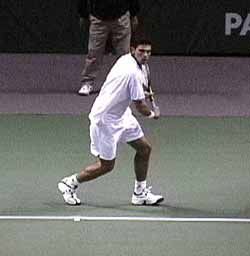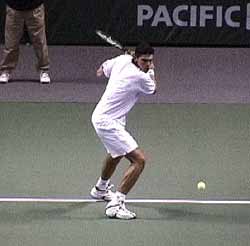|
TennisOne Lessons
Backhand…the word strikes fear in the hearts of many tennis players. However, once you’ve selected the backhand that’s right for you, like any other stroke, it’s simply a matter of understanding its key aspects and then replicating them until the desired results are achieved. Let’s start by examining the critical importance
of preparation on the one-handed backhand drive, using some of the
world’s greatest pros like Patrick Rafter and Mark Philippoussis as
examples. (We’ll cover the slice and two handed backhands in subsequent
articles). Prior to receiving a shot on your backhand side your eyes should be fixed on the ball coming off your opponent’s racket. In addition, just before the ball is struck make a controlled ready hop to set your leg muscles for the move to the ball. The combination of these things will provide a quicker response and keep you from having to guess the direction your opponent will hit the ball.
One of the most common problems I see when new
students come to my teaching court is the incorrect alignment of the feet,
especially on the one handed backhand. Your first step should be with the
left foot (this is for a right-hander, it's the reverse for lefties). The key
is to load all the weight onto the back leg prior to stepping in. This should leave your lower half in a relatively
open
stance.
No matter how far you move to the ball, you need to transfer your weight effectively and create a forward avenue with your feet. The step should be with the front foot pointing somewhere between 45 and 90 degrees to the net, so that you don’t block your hips. This is something great one-handers do without thinking, and you can make it as natural and automatic yourself. A related mistake that is also very common on the one handed backhand is an incomplete turn. The remedy for this is simple. You are fully turned when your hitting shoulder is tucked under your chin, while keeping your head level and eyes squarely on the ball. At this point, about half of your back is facing your opponent. The difference between doing this and not is huge! Your swing will be more effortless and potentially powerful.
An integral part of the turn is the grip change. A one-hander, at a minimum, should use an Eastern Backhand grip as it puts the wrist more behind the handle for essential support. I see too many one-handers flailing at the ball while using their Forehand or even Continental grips, which should be reserved for the slice backhand. There’s just not enough support with the wrist on top of the handle to avoid being wristy. Even with the correct grip make sure to lock your wrist in. This means the angle of the wrist should be at about 45 degrees to the forearm. Be sure to keep your non-hitting hand on the racket through the take back and until JUST before you begin the forward swing. This facilitates the grip change and steadies the racket. Page 2Your comments are welcome. Let us know what you about think Scott Murphy's article by emailing us here at TennisONE. Scott Murphy is one of America's top teaching pros. He is the director of the Nike Tahoe Tennis Camp. He has taught privately in Marin County, California for twenty years. A high level senior player, Scott has been ranked numerous times in both singles and doubles in Northern California. Scott is already well known to TennisONE readers for his great "Ask the Pro" answers.
|
Last Updated 1/1/01. To contact us, please email to: webmaster@tennisone.com TennisONE is a registered trademark of TennisONE and SportsWeb ONE; Copyright 1995. All rights reserved. |
|||||||||||||






